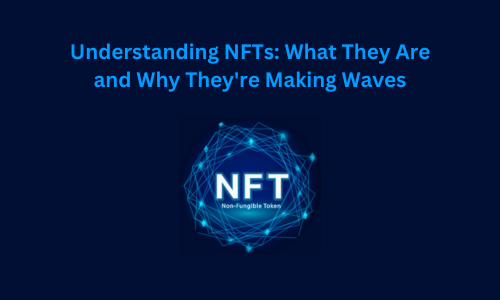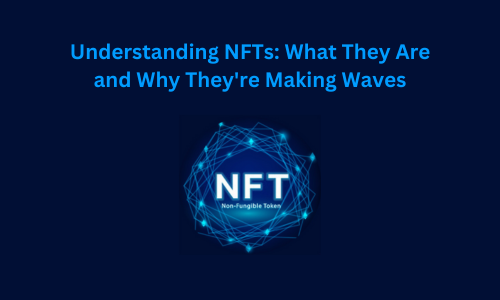


In recent years, the digital landscape has been transformed by a new phenomenon: NFTs, or Non-Fungible Tokens. From digital art to virtual real estate, NFTs have captured the imagination of creators, collectors, and investors alike. But what exactly are NFTs, and why are they generating so much buzz? Let’s dive in.
NFTs are unique digital assets that represent ownership of a specific item or piece of content, verified through blockchain technology. Unlike cryptocurrencies such as Bitcoin or Ethereum, which are fungible (meaning each unit is identical and can be exchanged on a one-to-one basis), NFTs are non-fungible. This means that each NFT is unique and cannot be replaced by another identical item.
The concept of NFTs first gained traction in 2017 with projects like CryptoKitties, a blockchain-based game where players could buy, sell, and breed digital cats. However, NFTs truly exploded into the mainstream in 2020 and 2021, with the rise of digital art platforms and the advent of high-profile sales, such as Beeple’s "Everydays: The First 5000 Days," which sold for a staggering $69 million.
At the heart of NFTs is blockchain technology. A blockchain is a decentralized, transparent ledger that records transactions across a network of computers. When an NFT is created, or "minted," it is assigned a unique identifier and stored on a blockchain. This identifier ensures the NFT’s uniqueness and allows it to be tracked as it is bought, sold, or traded.
Most NFTs are built on the Ethereum blockchain, which supports smart contracts—self-executing contracts with the terms of the agreement directly written into code. These smart contracts facilitate the transfer and ownership of NFTs, making the process secure and transparent.
NFTs come in various forms, each catering to different interests and industries. Some of the most popular types include:
Digital Art and Collectibles: Perhaps the most well-known use of NFTs, digital art has seen a revolution with artists selling their work as NFTs. Collections like CryptoPunks and the Bored Ape Yacht Club have become iconic, with some pieces selling for millions of dollars.
Music and Media: Musicians and creators are leveraging NFTs to sell unique tracks, albums, and other media directly to fans. This model allows for new revenue streams and deeper connections with audiences.
Gaming: In the gaming industry, NFTs are used to represent in-game assets, such as weapons, characters, or even virtual land. Games like Axie Infinity and Decentraland have embraced NFTs, creating vibrant economies around digital items.
Virtual Real Estate: Platforms like Decentraland and The Sandbox allow users to purchase virtual land as NFTs. These parcels of digital real estate can be developed, traded, or even monetized, mirroring real-world property markets.
Domain Names: Blockchain-based domain names, such as those offered by Unstoppable Domains, are another form of NFTs. These domains are decentralized, giving the owner full control without the need for traditional domain registrars.
NFTs have become a hot topic for several reasons, each contributing to their meteoric rise in the digital world:
Ownership and Provenance: NFTs offer a way to verify and prove ownership of digital items. In a world where digital content can be easily copied, NFTs provide a solution by creating a verifiable record of ownership, complete with the item’s history and origin.
Empowering the Creator Economy: NFTs are revolutionizing the way creators monetize their work. By cutting out intermediaries, artists, musicians, and other creators can sell directly to their audiences, retaining more control over their content and earnings.
Speculation and Investment: The potential for significant returns has driven much of the interest in NFTs. Investors and collectors are drawn to the possibility of buying a digital asset today and selling it for a substantial profit tomorrow.
Cultural Impact and FOMO: NFTs have become a cultural phenomenon, with high-profile sales and celebrity involvement creating a sense of urgency and exclusivity. The fear of missing out (FOMO) drives many to jump into the NFT market, hoping to capitalize on the trend.
Celebrity and Brand Involvement: From sports stars to fashion brands, a growing number of celebrities and major companies are embracing NFTs. This involvement has helped to legitimize the market and attract even more attention.
Despite the excitement, NFTs are not without their challenges and criticisms:
Environmental Concerns: The process of minting and transacting NFTs on certain blockchains, particularly Ethereum, can be energy-intensive. This has raised concerns about the environmental impact of NFTs, with critics pointing to the carbon footprint associated with blockchain technology.
Scams and Fraud: As with any emerging market, the NFT space has seen its share of scams and fraud. Fake NFTs, phishing attacks, and other schemes have become increasingly common, making it crucial for buyers and sellers to exercise caution.
Market Volatility: The NFT market is highly speculative, with prices that can soar or plummet seemingly overnight. This volatility can lead to significant financial risks for those looking to invest in NFTs.
Intellectual Property Issues: The rise of NFTs has also sparked debates around intellectual property rights. Questions about copyright infringement and the legal ownership of digital assets continue to be a contentious issue in the NFT space.
The future of NFTs is still taking shape, but several trends and developments suggest they are here to stay:
Evolving Technology: As blockchain technology evolves, new solutions are emerging to address some of the current challenges. For example, Ethereum 2.0 and Layer 2 solutions aim to reduce the environmental impact and improve the scalability of NFTs.
Broader Adoption: NFTs are poised for broader adoption across various industries, from real estate to fashion. As more companies and creators explore the potential of NFTs, we can expect to see new and innovative use cases emerge.
Regulation: As the NFT market grows, so too does the conversation around regulation. Governments and regulatory bodies are beginning to pay closer attention to NFTs, which could lead to new rules and guidelines that shape the market’s future.
NFTs represent a fascinating intersection of technology, art, and commerce. They offer a new way to own and experience digital content, while also raising important questions about the future of ownership, creativity, and value in the digital age. As with any emerging technology, the road ahead for NFTs will likely be a mix of innovation, challenges, and opportunities.
Whether you’re a creator, collector, or simply curious about the digital world, understanding NFTs is key to navigating this rapidly evolving landscape. While the market may be volatile, the underlying technology and the possibilities it presents suggest that NFTs will continue to be a significant force in the digital arena for years to come.
Disclaimer: This article is provided for informational purposes only. It is not offered or intended to be used as legal, tax, investment, financial, or other advice.
